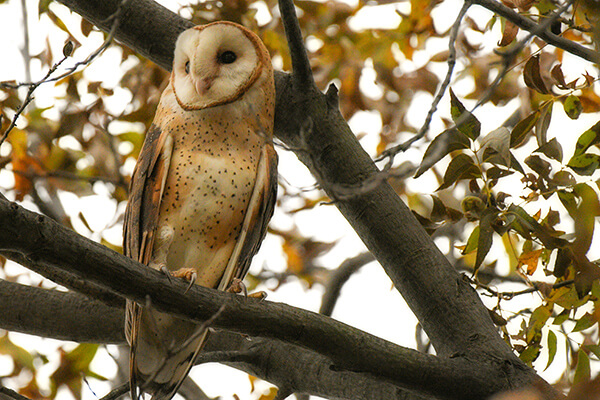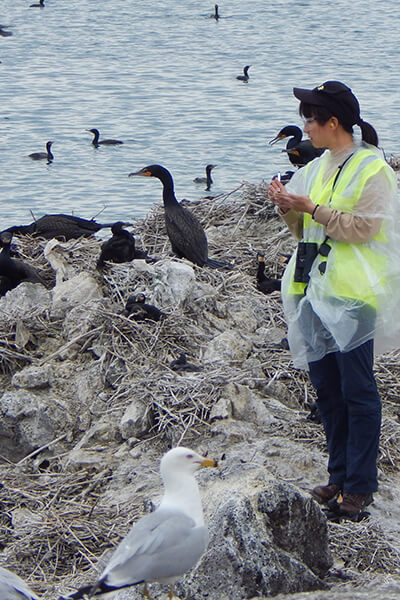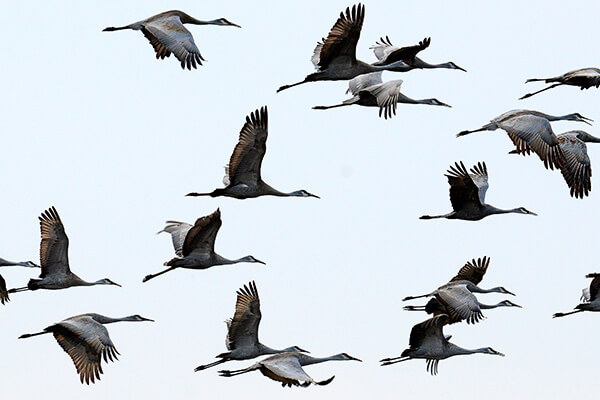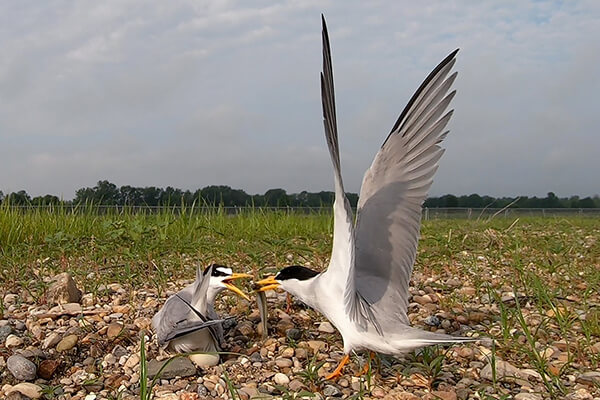Select image to enlarge and view caption.
Birds
Birds, collectively known as “avifauna”, can be found in nearly every habitat in the state, including lakes, rivers, wetlands, forests, prairies, glades, and dunes, as well as in more human-influenced areas like agricultural, residential, urban, and industrial spaces. Although many species like the common American robin or northern cardinal are easily seen, there are species that are rarer and more elusive, like the secretive sora rail that hides in Indiana’s vegetated wetlands. Even more elusive are bird nests. These may be placed in a variety of natural places like tree branches, peeled bark or cavities, tufts of grass, a stream bank, or simply on the ground. Birds also nest in some unexpected man-made places like sheds, rooftops, fences, gutters, or potted plants. Because birds appear in many places, they provide people with the opportunity to observe wildlife in their everyday lives.
Indiana’s wonderfully diverse birdlife offers a dedicated birdwatcher the opportunity to see more than 300 species in the state annually. More than 420 species have been documented, a total that includes rare and accidental species that wander beyond their normal geographic ranges. Because most of Indiana’s bird species are migratory, some may spend entire winters here, while others may spend only one-third or less of their time using Indiana’s habitats as nesting sites or temporary stopovers to rest during their journeys. Of these species, 53 are listed as a Species of Greatest Conservation Need by the Indiana DNR.
Habitat management and conservation programs for these species are supported through the generosity of Hoosiers who donate to the Indiana Nongame Wildlife Fund. No state tax dollars are used to manage these species. Consider donating today.
Monitoring Bird Populations
Indiana DNR ornithologists conduct research and monitoring to better understand the status and distribution of Indiana’s birds. Species currently being studied include peregrine falcons, least terns, loggerhead shrikes, marshbirds (rails and bitterns), barn owls, whooping cranes, migratory shorebirds (yellowlegs, plovers, and sandpipers), ospreys, sandhill cranes, and colonial waterbirds (night-herons and egrets).
- Barn Owls
Barn owls are a state endangered species due to loss of permanent grassland habitats for them to hunt, such as pastures, hayfields, and prairies. They also need cavities in large trees or structures like haylofts, steeples, and silos in which to raise their young. To augment Indiana’s barn owl population, biologists and volunteers have installed more than 400 nest boxes during the past three decades to provide nesting opportunities that are protected from severe weather and predators. A statewide check of 355 barn owl nest boxes in 2022 found a record-high 82 active nests. Of these active nests, 75 (91%) were in nest boxes installed on interior barn walls. Nearly all nest boxes (337 or 95%) are on private property.
- Loggerhead Shrikes
The loggerhead shrike is a robin-sized songbird that earned the nickname “butcher bird” due to its habit of hanging prey on thorns or barbed wire. Shrike populations in Indiana have declined dramatically due to loss of quality breeding habitat, pesticide use, and increasing development of their wintering grounds. Fewer than 10 breeding pairs are found statewide each year.
The Indiana DNR and its partners have planted more than 70 Eastern red cedar bushes as part of the “Shrubs for Shrikes” program. This successful partnership provides quality habitat on private land where shrikes are known to nest and spend their winters. Monitoring efforts have documented loggerhead shrikes using these planted cedars for nesting and escape cover.
- Whooping Cranes
The whooping crane is one of the rarest species in North America, with fewer than 900 individuals remaining. Those that migrate through Indiana or spend their winters here belong to the experimental Eastern Migratory Population, which totals about 100 birds. They are most commonly found overwintering on or near Goose Pond FWA but are also found annually at Jasper-Pulaski FWA and two national wildlife refuges in Indiana. Indiana DNR helps the International Crane Foundation monitor whooping cranes each winter and assists in the capture of specific cranes to replace their non-functioning or damaged tags, which, when working, help track each bird’s movements.
- Least Terns
The least tern, the smallest tern species in North America, nests along Indiana’s rivers in spring and summer. Unlike some common birds, least terns do not build nests out of twigs, grass, and other vegetation, but form small depressions in sand or gravel to secure their eggs. Natural nest sites occur on river islands and sandbars, but these areas are often disturbed by human recreationalists and severe floods that displace nesting terns. Indiana DNR and partners conserve least terns by closely monitoring and managing several nesting colonies in southern Indiana. These include artificially created islands built at Goose Pond FWA and Cane Ridge Wildlife Management Area specifically for terns.
- Breeding Bird Atlas
The Breeding Bird Atlas is a comprehensive survey that inventories the bird species that breed in Indiana. In 2023, the second atlas was published and is now available for download: Atlas of Breeding Birds of Indiana, 2005-2011. Learn more about the Breeding Bird Atlas.




